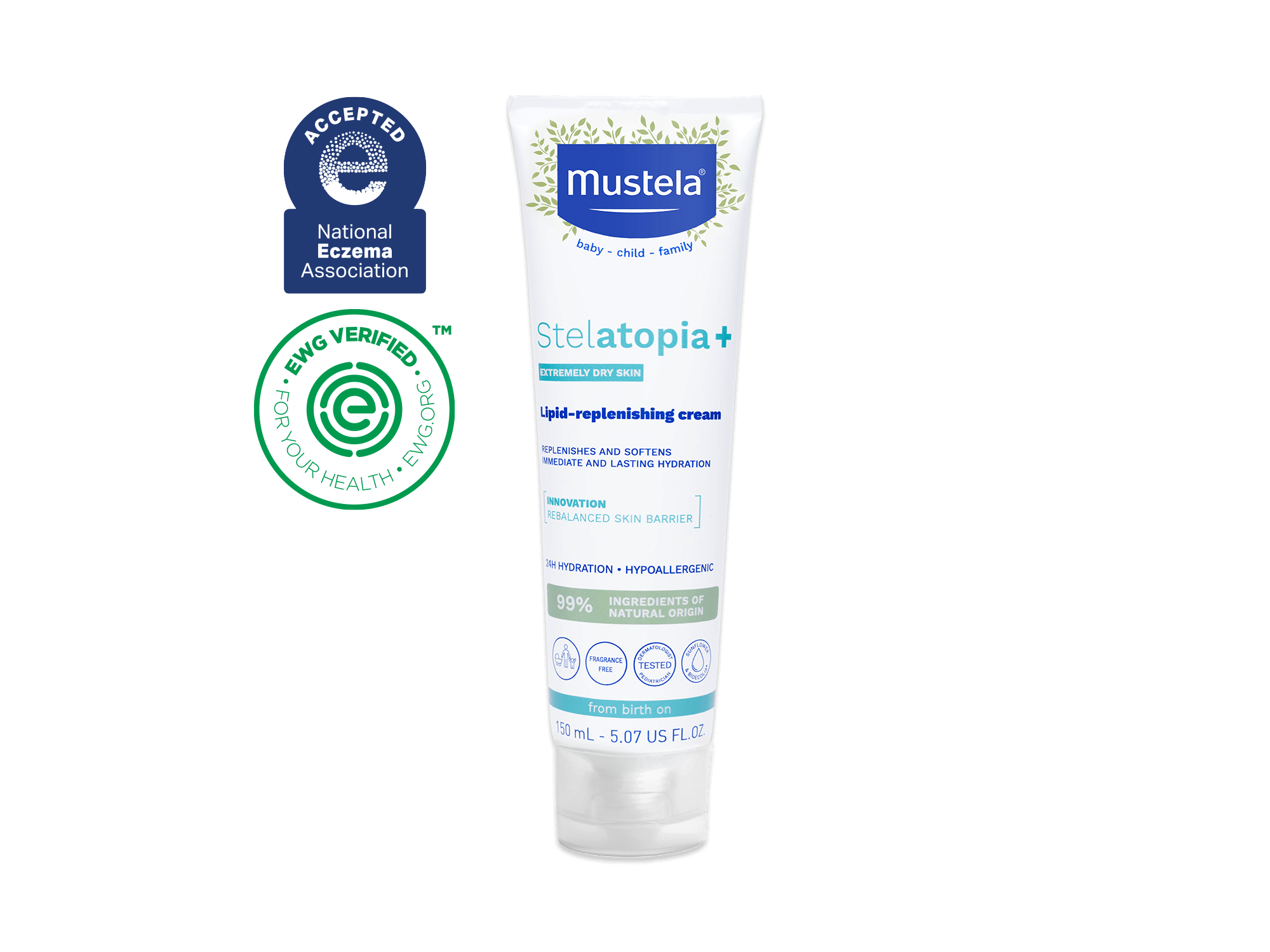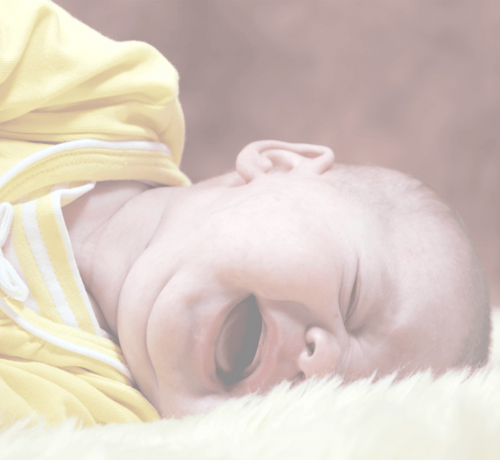Your baby’s skin is soft, delicate, and smells oh-so-sweet. And it’s no less than worrisome when you notice pesky bumps, a red rash, or itchy patches on your little one’s skin. But take a deep breath — many baby skin conditions are quite common and are not cause for concern.
To help you care for your baby and their skin, the experts at Mustela have outlined five common baby skin conditions and their causes, symptoms, and treatments. However, it’s important to give your doctor a call right away if you notice an unusual rash or changes in your child’s skin.
Five Common Baby Skin Conditions
1) Baby Acne
Cause
Acne only strikes teens and adults, right? Actually, no. Around 20 or 30 percent of babies have baby acne, also known as neonatal acne.
While doctors aren’t completely sure what causes this baby skin condition, it could be related to hormones from mom (leftover from the womb or transferred through breastfeeding), a certain type of yeast on your baby’s skin, or an imbalance of probiotics.
Symptoms
Baby acne typically appears on the forehead, nose, cheeks, or back. Similar to adult acne, your little one’s acne will look like small red bumps, pimples, or even whiteheads. It might be present at birth, but you may also notice it during the first few weeks or months of your child’s life.
Treatment
First, avoid picking at the bumps and try to keep your baby from picking or scratching. If you need to, put mittens or socks on their hands to keep them from scratching and to give the acne time to heal.
Additionally, reduce irritation by patting (instead of rubbing) baby’s skin dry and dressing them in soft, soothing clothes.

To care for baby acne, use a gentle cleanser and a light lotion, like Mustela’s Hydra Bébé Facial Cream, which is designed specifically for baby’s skin.
Between bath times or if you’re on the go, try Mustela’s No Rinse Cleansing Water to keep your baby’s face (and the rest of their body) clean, soft, and acne-free. No need to rinse with water!
If your baby’s acne is particularly extensive or stubborn, your pediatrician might recommend an ointment or cream, such as a 2.5% benzoyl peroxide lotion. Be careful with over-the-counter treatments — your little one’s skin is sensitive, so you’ll want to use products that are gentle and won’t irritate their skin.
If you decide to use an over-the-counter ointment, avoid a reaction by testing it on a small area of your baby’s skin before applying it to their whole face or body.
2) Milia
Cause
Speaking of baby acne, milia is a similar baby skin condition. About 50 percent of babies have milia, which is simply the result of blocked pores on your little one’s skin.
Symptoms
What does milia look like? Small, white bumps that usually appear on baby’s face, particularly on their nose but also on their forehead, cheeks, and chin, or sometimes even other parts of the body.
Don’t worry; milia bumps do not itch and are not contagious.
Treatment
The great news about this baby skin condition is that it goes away by itself within the first few weeks of baby’s life! Rest easy. Milia is no cause for concern.
3) Eczema
Cause
Eczema can be a frustrating baby skin condition because the exact cause is unknown and there’s no sure-fire cure. What we do know is that eczema, scientifically known as atopic dermatitis, can run in the family and is triggered by environmental irritants.

Symptoms
This itchy condition usually shows up from the first few months to five years of a child’s life. You’ll notice reddish, rough, dry, itchy skin anywhere on their body, but especially on their face (particularly their cheeks) as well as arm and leg joints.
Treatment
Many children will outgrow eczema, but in the meantime, your job as a parent is to keep them comfortable and reduce allergens and irritants that can cause flare-ups.
Additionally, dress your little one in clothes that will be soft and non-irritating. Mustela’s Stelatopia Skin Soothing Pajamas are a great way to give your eczema-prone baby a comfortable night of sleep.

Another way to calm your baby’s eczema is to moisturize their delicate skin with products and lotions made specifically for eczema-prone babies. Mustela’s fragrance-free Stelatopia Emollient Cream reinforces the skin’s moisture barrier and soothes discomfort.
Finally, speak with your pediatrician about the possibility of allergens in your child’s diet contributing to their eczema. You’ll also want to mention to your doctor if your child has just developed eczema or if their eczema starts oozing, develops blisters, or becomes infected.
4) Diaper Rash
Cause
Every parent knows the joys of dealing with dirty diapers, and many parents may, at one point or another, find themselves face-to-face with diaper rash.
Diaper rash is usually caused by irritation and bacteria growth from dirty and wet diapers. Extra-sensitive skin or changes in your little one’s diet — and, as a result, their stool — can also contribute to diaper rash.
Symptoms
Diaper rash is hard to miss. It looks like red, irritated skin in and around the diaper area. It could also be puffy or warm to the touch, and you might see small bumps.
Diaper rash can be uncomfortable, so you may notice that your baby’s skin is particularly sensitive during diaper changing.
Treatment
With the proper care, diaper rash usually goes away easily. However, you’ll want to call your doctor if you notice that your child has a fever or if you see pus, blisters, cracked skin, or bleeding in the diaper area.
What can you do to get rid of diaper rash and keep your baby’s bottom comfortable in the meantime? Be sure to change their diaper frequently so that they’re not sitting in a wet or dirty diaper, which is a breeding ground for bacteria.

When you change your little one’s diaper, clean and dry their bottom thoroughly before putting a clean diaper on. Also, be gentle with the irritated diaper rash area — use gentle baby wipes and apply a soothing diaper cream.
Expert tip: Mustela’s Diaper Rash Cream 1 2 3 relieves irritation and redness and helps prevent diaper rash with every diaper change. And our Diaper Rash Sprayable Cream provides a touch-free solution to baby bum irritation.
Finally, find some time to let your baby run free without a diaper to completely dry and air out their bottom.
5) Cradle Cap
Cause
Cradle cap is another baby skin condition with an unknown cause. However, you can rest assured it’s not the result of poor hygiene, an allergic reaction, or bacterial infection.
Potential causes include hormones from the mother (from the womb or breast milk), a yeast imbalance, immunodeficiency, or fungal infection.
Whatever the cause, around 10 percent of babies develop cradle cap. The good news is that it’s harmless to your little one and is not contagious.
Symptoms
Cradle cap is a red or yellow irritated area that usually forms a scaly or crusty build-up that sticks to your baby’s skin. As you may have guessed from the name, this condition is most commonly seen on the head or face, but it can appear elsewhere on your baby’s body as well.
Treatment
While your baby’s skin will typically stabilize itself and cradle cap will go away with time, it pays to take good care of your little one’s skin to keep them as comfortable as possible. Resist the urge to pick off the crusty skin. Instead, gently brush your baby’s head with a soft brush and baby oil.

While it’s important to keep your little one’s skin clean, try not to bathe them more than once per day. Too-frequent baths can dry out their skin, which can worsen your little one’s cradle cap.
You’ll also want to avoid harsh products during bathtime. Instead, use a gentle shampoo and (even better!) products specifically designed for cradle cap. Mustela has just what your baby needs with the Cradle Cap Duo — a shampoo and cream designed to cleanse and soften irritated skin.
To prevent infection, avoid rough, scratchy clothing or bedding and try to keep your baby from scratching themselves. Keep their fingernails trimmed short and cover their hands with socks or mittens if needed. And, of course, if your baby’s cradle cap does appear to be infected, give your pediatrician a call.

While any baby skin condition is alarming at first, with this information and a few of the right cradle cap products from Mustela to treat and soothe your little one, you can rest easy knowing that your baby’s skin will soon be back to it’s soft, kissable condition.


















